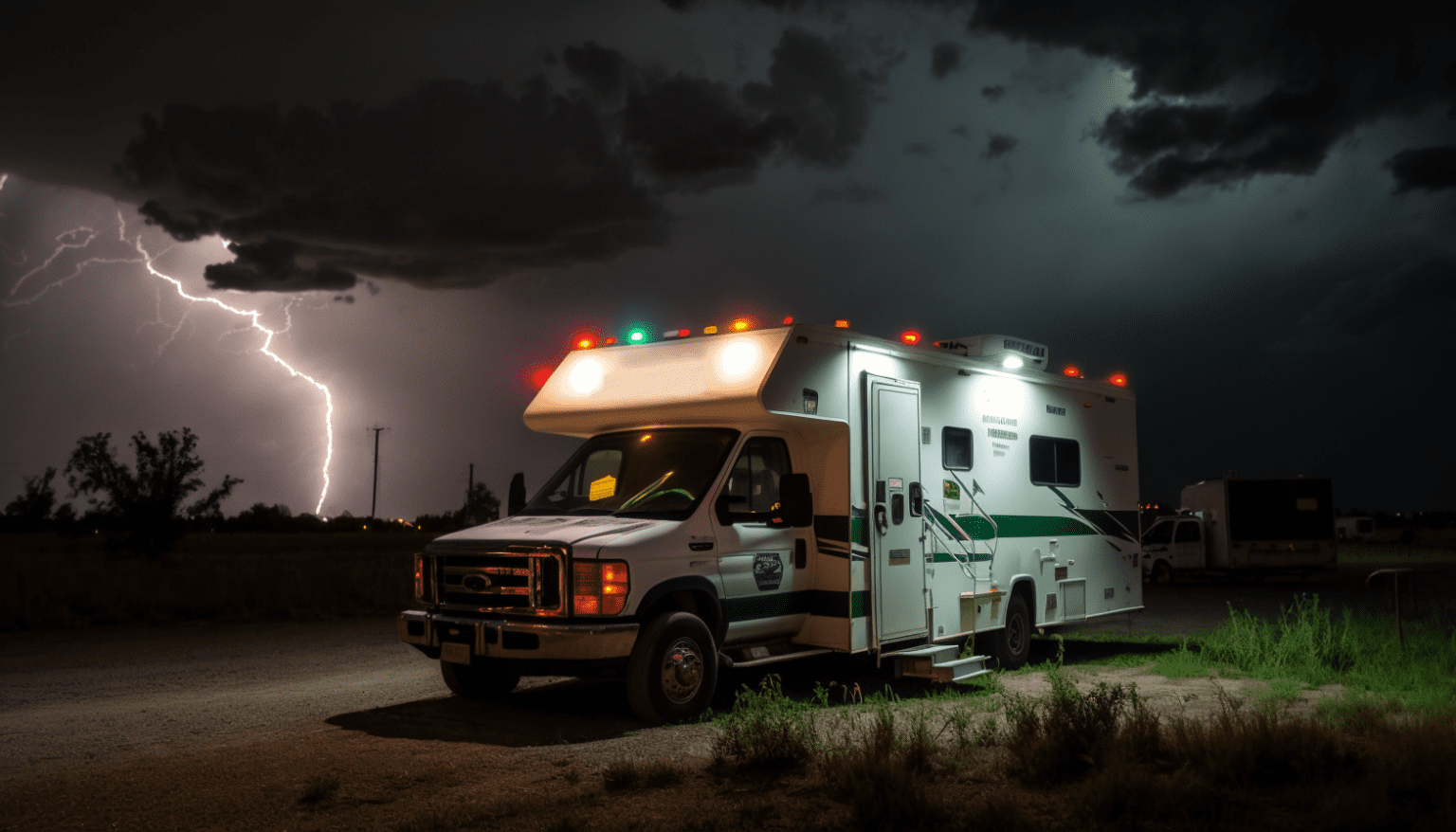What an RV Surge Protector Actually Does (Without the Techno-Babble)
Power surges don’t wait for a good time. They hit while you’re halfway through reheating chili in the microwave or when your A/C finally hits the sweet spot after a humid 95° afternoon. That’s where RV surge protectors step in. It acts like a bouncer for your electrical system—blocking voltage spikes, reverse polarity, and open grounds from frying your gear.
These devices monitor shore power, detect bad connections, and—if you get the good kind—can shut down power automatically if things get sketchy. We’re talking joule ratings, clamping voltage, and even auto shutoff features. Some models even throw in Bluetooth monitoring and real-time voltage readouts, because apparently, your coffee maker needs data analytics now.
Look, this isn’t just another overpriced gadget. With campground hookups being about as trustworthy as a $3 steak, having something between you and that mystery juice coming out of the power pedestal is a necessity—not a luxury.
Key Takeaways
- RV surge protectors defend your rig from power surges, low voltage, and faulty wiring.
- Don’t cheap out. Quality units from Progressive Industries, Hughes Autoformers, and Southwire are worth it.
- Choose based on your rig’s needs: 30-amp vs 50-amp, portable vs hardwired.
- Look for real specs: joule rating, clamping voltage, and UL certification.
- Register your warranty and keep your surge protector clean, dry, and locked down.
Common Power Hazards RVers Face (And What’s Cooking Your Gear)
RV electrical systems weren’t built for chaos, but campground power often is. One minute your microwave hums happily, the next it’s dead and your converter smells like burnt regret. That’s usually thanks to power surges, voltage drops, or someone plugging in their Class A monster rig next to you and taking out half the park.
Even newer campgrounds can dish out reverse polarity, open neutral, or just straight-up low voltage that cooks your air conditioner without warning. If you’ve ever seen flickering lights, heard a breaker pop for no reason, or felt your surge protector kick in mid-toast, that’s not a fluke. That’s poor power.
Your fridge, battery charger, and inverter aren’t fans of brownouts either. These slow, creeping voltage dips quietly wear them down until you’re replacing appliances at a pace that makes extended warranties look smart.
Some folks don’t believe it until they see their transfer switch catch fire or their TV go blank in a storm. At that point, they’re paying for overnight shipping on something they should’ve already had. Don’t be that person.
Surge Protector Types Explained Like You’re Standing at the Campground Hookup
RV surge protectors aren’t all built the same, and if you’ve ever stood at a campground pedestal scratching your head while holding a tangled mess of cords, you already know that.
The most common types are plug-in surge protectors—you just connect them between your rig and the power source. Easy. No tools, no wiring, just plug and pray. Then there are hardwired surge protectors, which live permanently inside your rig. They’re more protected, harder to steal, but installation isn’t exactly a weekend hobby unless you enjoy small shocks and swearing.
Portable surge protectors usually offer great protection with visual LED indicators, and many newer ones include Bluetooth connectivity, so you can watch your voltage crash in real-time on your phone from inside the rig. If you like playing “Is my power about to fail?” this is your game.
Then there’s the EMS route—Electrical Management Systems. These take things further with over/under voltage protection, automatic shutoff, and advanced diagnostics. You’ll pay more, but these units actually prevent damage, not just complain about it.
Bottom line: If you’re plugging into questionable power (and you are), you’ll want more than just a plastic box with lights on it.
What to Look For in a Real Surge Protector (Not the $25 Amazon Trap)
Not all RV surge protectors are built to survive campground roulette. That $25 deal you saw online? It’s probably more useful as a paperweight. A solid unit needs real protection—starting with a high joule rating. This tells you how much energy it can absorb before waving the white flag. For real coverage, you’re looking for 2,000 joules and up.
Then there’s clamping voltage—the level at which the unit starts absorbing excess voltage. Lower is better. If the number’s too high, it might just sit there watching your air conditioner fry like it’s not its job.
Response time matters too. A good surge protector acts in nanoseconds. If it hesitates, your fridge, TV, or power converter eats the hit. Make sure it’s UL listed—no certification means it probably hasn’t been tested against real-world disasters like a campground in rural Texas during July.
Now let’s talk features. Real units come with LCD displays, not just blinking lights. Some even give you error codes, voltage readouts, and surge counts. And yes, a few of them can sync with your phone via Bluetooth, which sounds excessive until it saves your gear from a bad hookup while you’re still outside leveling the rig.
Skip the off-brand stuff with spelling mistakes in the manual. If it can’t spell “protection,” it probably can’t provide it either.
Top Picks for 2025 (Based on Testing, Not Just Amazon Reviews)
Let’s skip the fluff and get into what’s actually worth plugging into. These aren’t the prettiest gadgets, but they’re the ones you want when the campground power pedestal sounds like it’s trying to launch a satellite.
Progressive Industries EMS-PT30X / EMS-PT50X
These are the gold standard for a reason. They offer full EMS protection, weatherproof housing, real-time voltage readouts, and automatic shutoff for everything from low voltage to reverse polarity. Plus, a lifetime warranty that actually means something. Expensive? Yep. Worth it? Absolutely.
- ELECTRONIC SAFETY MAINTAINED: Protects RV electronics from voltage fluctuations and power surges; includes built-in elec…
- SURGE PROTECTION FOR RV: Rated for 30 Amp and 120 V with 3,600 W capacity; absorbs surges up to 1,790 joules; helps prev…
- POWERFUL FAULT DETECTION: Guards against over and under voltage, open ground and neutral, reverse polarity, miswired ped…

Hughes Autoformers PWD30-EPO / PWD50-EPO
These guys get points for their Bluetooth monitoring, auto shutoff, and optional replaceable modules—which is huge if you don’t want to toss the whole thing after one nasty surge. Great visibility with LED indicators and a slick phone app.
- 30 amp Power Watchdog Smart Surge Protector offers 3,000 Joules of advanced surge protection for your coach. It features…
- Replaceable Surge / Spike Module – should you get hit by a large spike, simply order a new surge module rather than repl…
- Wirelessly Monitor voltage, amperage, and wattage on your smartphone in real time using our free mobile app
Southwire Surge Guard 34930 / 34950
Think of this as the reliable workhorse. It offers EMI/RFI protection, automatic shutoff, and both open neutral and reverse polarity detection. A bit bulky, but it’s built to take abuse and keep your rig powered safely.
- Continuously monitors for and displays voltage and amp draw (RMS)
- LCD display (English)
- 10 second start up sequence

Camco PowerDefender 55306
This one’s for the budget-minded who still want legit protection. It’s got weatherproofing, decent joule rating, and a solid brand reputation. It doesn’t come with smart tech, but it’ll keep your microwave and fridge alive.
- RV Electrical Protection: Protects your electrical equipment from power surges
- Diagnostic LEDs: Provide indication of faults when you connect your electrical cord to the power pedestal; Indicates Wir…
- Integrated Surge Protection: Up to 4,200 Joules; 50-Amp: 50-Amp male (NEMA 14-50P)/50-Amp female (NEMA 14-50R)
Each of these has options for 30-amp and 50-amp RVs, so don’t mix them up unless you enjoy replacing fuses and yelling.
The Best Option by Scenario (Because Not Everyone Lives in a Class A)
There’s no one-size-fits-all surge protector—unless your rig’s a one-size-fits-all pile of scrap. Here’s what works best depending on how you roll.
Best for Weekenders
You’re plugging in Friday night and gone by Sunday. The Camco PowerDefender or a basic Surge Guard portable unit will give you decent protection without wrecking your budget. They’re light, easy to store, and you won’t cry if they get left behind.
Best for Full-Timers
You’re living in this thing. Get serious. The Progressive Industries EMS-PT50X or Hughes PWD50-EPO gives full monitoring, high surge capacity, and auto shutoff when the power goes sideways. Plus, you’ll want the peace of mind that comes with a lifetime warranty and diagnostics.
Best for Budget-Conscious RVers
We’ve all done the math on campground fees vs. fast food. If every dollar counts, the Camco 55306 or Southwire 44260 keeps you protected without dipping into your taco budget. No app, no frills—just the basics done right.
Best for Tech-Savvy Users
Want real-time voltage on your phone? Look at Hughes Autoformers Watchdog. The app tracks power surges, alerts you to voltage issues, and even logs data so you can blame the pedestal with evidence.
Best for Brutal Weather Conditions
If you’re out there in snow, rain, or desert dust, you’ll need weatherproof housing, shock-resistant casing, and sealed connectors. The Progressive Industries hardwired units are built for this, and they won’t short out the first time a thunderstorm rolls in.
How to Avoid the Junk: Red Flags When Buying an RV Surge Protector
You’d think avoiding garbage products would be simple—read a few reviews, check the stars, done. Nope. Some of the worst offenders in the RV surge protector world have glowing five-star reviews from people who haven’t even plugged them in yet.
“Too cheap to be good” is real. If it’s under $50 and claims to protect against everything short of nuclear war, you’re looking at a glorified extension cord. Real units cost more because they include thermal protection, fault detection, and internal circuit boards that don’t melt under pressure.
Watch out for fake certifications. If the box says “UL-Like Certified” or the label is just a sticker that says “Tested by Experts,” run. Real surge protectors list UL, ETL, or CSA approvals and include a certification number you can actually verify.
If there’s no warranty or it’s something like “30-day return only,” that’s a red flag. Legit brands like Progressive Industries and Hughes Autoformers give multi-year or lifetime warranties, because they’re not expecting their product to fail after one lightning storm.
Lastly, vague surge capacity numbers like “Protects from power spikes” mean nothing. You want joule rating, clamping voltage, and response time listed in real numbers. No specs? No buy.
Installation Tips & Power Hookup Do’s and Don’ts
Installing an RV surge protector isn’t rocket science, but people still manage to mess it up—usually right before a thunderstorm or after a long day on the road.
Portable Surge Protector Tips
- Always plug the surge protector into the power pedestal first, then plug in your RV.
- Use a lock or cable to keep it from walking away. Yes, people steal them. No, it’s not uncommon.
- Don’t let it dangle or rest in a puddle. Use a weather cover or hang it safely with a hook.
Hardwired Installation Advice
- If you’re even slightly unsure, pay a pro. One crossed wire and you’re shorting your electrical system.
- Mount the unit inside a dry area, typically behind the breaker panel or near the transfer switch.
- Label everything. If you forget what goes where during a repair, future-you will thank past-you.
General Hookup Do’s and Don’ts
- DO test the pedestal with a polarity tester before plugging in.
- DON’T skip checking for open neutral or reverse polarity—this is how rigs get fried.
- DO unplug during lightning storms if you’re not using an EMS unit.
- DON’T assume every campground has clean power. Most don’t.
It’s not just about plugging in—it’s about plugging in smart so your fridge, TV, and microwave don’t become campfire stories.
Maintenance & Warranty Tips So You’re Not Screwed Later
Just because your RV surge protector is built tough doesn’t mean it’s immortal. Like most gear, it wears down—especially if it’s eaten a few surges already.
Check for Visible Damage
Cracks in the casing? Burn marks? Melted connectors? That’s a no-go. Even if the lights still blink, compromised housing means moisture and dirt can get inside, and that’s how you end up replacing more than just a $200 surge protector.
Keep an Eye on the Surge Count
Some models, like Progressive Industries EMS units, track how many hits they’ve taken. If it’s climbed into double digits, it might be time to replace it—especially if your joule rating is on the lower side.
Register Your Warranty
A lot of brands offer great warranty coverage—but only if you register the product. Don’t wait until it’s toast. Keep your receipt, snap a photo of the serial number, and fill out the form online. Yes, it’s annoying. No, they won’t help you without it.
Know What the Warranty Doesn’t Cover
Most won’t replace the unit if you installed it wrong, used the wrong amperage, or let it sit out in the rain without a cover. So read the fine print. If something’s labeled “weather-resistant,” that’s not the same as waterproof—ask anyone who’s fried one in a Florida thunderstorm.
Replace When It’s Time
Don’t cheap out. If your unit’s several years old and has taken some hits, get a new one. It’s a lot cheaper than replacing a power converter, battery bank, or microwave oven.
Final Thoughts on Surge Protection (Don’t Be That Guy at the RV Park)
Every RV park has that guy—the one yelling about how his TV’s toast, the microwave’s dead, and the air conditioner blew out during lunch. All because he didn’t want to drop a few bucks on a decent surge protector.
The truth is, power surges, low voltage, and bad wiring aren’t rare—they’re standard fare at a lot of campgrounds. That shiny new Class C you just financed? It’s one bad hookup away from needing serious repairs if you’re not protected.
The options we covered—from Progressive Industries to Southwire Surge Guard—aren’t just gimmicks with LEDs. They’re actual defensive tools for your RV electrical system. And if you’re full-timing or traveling often, an EMS unit with auto shutoff and real-time monitoring is probably the best insurance you didn’t know you needed.
Skip the knock-offs, register your warranty, and use a lock. Because nothing ruins a weekend like realizing you saved $50 but cost yourself $2,000 in appliance damage.
FAQ
Do I need a 30-amp or 50-amp surge protector?
It depends on your RV’s power system. If you plug into a 30-amp outlet, get a 30-amp protector. Same goes for 50-amp. Using the wrong one can trip breakers or cause overheating.
Can I leave the surge protector plugged in all the time?
Yes, especially with hardwired models. For portable units, it’s safe as long as it’s protected from weather and theft.
Will a surge protector stop my AC from being fried?
It can’t save your AC unit from wear and tear, but it can prevent damage from low voltage, power surges, and bad wiring—common AC killers.
What’s the difference between EMS and a surge protector?
A basic surge protector blocks power spikes. An EMS (Electrical Management System) adds voltage monitoring, auto shutoff, and other protections for low voltage, open ground, and more.
How do I know if it’s working?
Most units have LED indicators or an LCD display showing voltage, faults, or errors. Others offer Bluetooth apps to check real-time status.
References
RV Surge Protector Manufacturers Reference Table
| Manufacturer | Notable Models | Key Features | Website |
|---|---|---|---|
| Progressive Industries | EMS-PT30X, EMS-PT50X, SSP-30XL | EMS protection, weatherproof, lifetime warranty, LCD display | progressiveindustries.net |
| Hughes Autoformers | PWD30-EPO, PWD50-EPO, Power Watchdog | Bluetooth monitoring, replaceable surge modules, auto shutoff | hughesautoformers.com |
| Southwire | Surge Guard 34930, 34950, 44260 | Open neutral protection, RFI/EMI filtering, auto reset | southwire.com |
| Camco | PowerDefender 55306, 55310 | Budget-friendly, weather-resistant, basic surge protection | camco.net |
| Technology Research (TRC) | Surge Guard (legacy series) | Foundational surge protection, early generator-compatible designs | southwire.com (TRC now under Southwire) |






